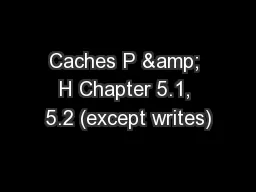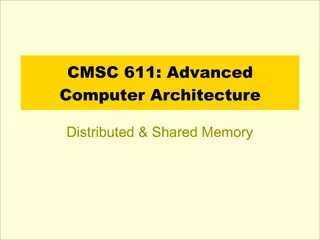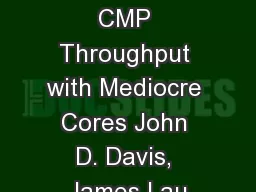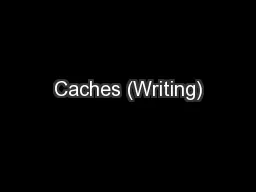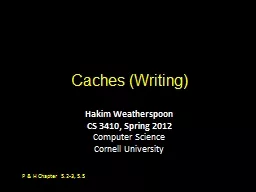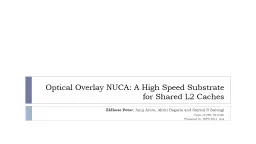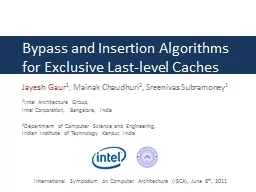PPT-Caches P & H Chapter 5.1, 5.2 (except writes)
Author : trish-goza | Published Date : 2018-12-20
Performance CPU clock rates 02ns 2ns 5GHz500MHz Technology Capacity GB Latency Tape 1 TB 17 100s of seconds Disk 1 TB 08 Millions cycles ms SSD Flash 128GB 3 Thousands
Presentation Embed Code
Download Presentation
Download Presentation The PPT/PDF document "Caches P & H Chapter 5.1, 5.2 (excep..." is the property of its rightful owner. Permission is granted to download and print the materials on this website for personal, non-commercial use only, and to display it on your personal computer provided you do not modify the materials and that you retain all copyright notices contained in the materials. By downloading content from our website, you accept the terms of this agreement.
Caches P & H Chapter 5.1, 5.2 (except writes): Transcript
Performance CPU clock rates 02ns 2ns 5GHz500MHz Technology Capacity GB Latency Tape 1 TB 17 100s of seconds Disk 1 TB 08 Millions cycles ms SSD Flash 128GB 3 Thousands of cycles us. And 57375en 57375ere Were None meets the standard for Range of Reading and Level of Text Complexity for grade 8 Its structure pacing and universal appeal make it an appropriate reading choice for reluctant readers 57375e book also o57373ers students Write-back: snoop in caches to find most recent copy* Slide is partia Write-invalidate has emerged as the winner for the vast Because the bus and memory bandwidth is usually in demand, write-invalida caches and data caches are always identical in size or differ by a factor of 2X, but no more. The primary caches range from 8 KB to 128 KB with SA ranging from direct mapped to 8-way. Small instruct MADONNA. Madonna's birth name is Madonna Louise Ciccone. She was born in Bay city, Michigan. She is a singer-songwriter and actress. Her career was further enchained by short film appearances that began in 1985. She also stared in a movie called . Doug Terry. Microsoft Research Silicon Valley. … Explained through Baseball. Data Replication in the Cloud. Question. : What consistency choices should cloud storage systems offer applications?. Some Popular Systems. UHCL Writing Center. C. S. Lewis . “We . all want progress, but if you're on the wrong road, progress means doing an about-turn and walking back to the right road; in that case, the man who turns back soonest is the most progressive. ECE . 751. Brian Coutinho. ,. David Schlais. ,. Gokul Ravi. &. Keshav . Mathur . Summary. Fact. : Accelerators gaining popularity - to improve performance and energy efficiency. Problem. : Accelerators with scratchpads require DMA calls to satisfy memory requests (among other overheads). Hakim Weatherspoon. CS 3410, Spring 2013. Computer Science. Cornell University. P & H Chapter . 5.2-3, 5.5. Goals for Today: caches. Writing . to the Cache. Write-through . vs. Write-back. Cache Parameter Tradeoffs. :. What is Cache Coherence?. When one Core writes to its own cache the other core gets to see it, when they read it out of its own cache.. Provides underlying guarantees for the programmer with respect to data validation.. CS 3410, Spring 2012. Computer Science. Cornell University. P & H Chapter . 5.2-3, 5.5. Goals for Today. Cache Parameter Tradeoffs. Cache Conscious Programming. Writing to the Cache. Write-through . February 2015. GEOCACHING. The Modern Treasure Hunt. What is . geocaching. ?. Geocaching.com definition:. “. Geocaching. is a real-world, outdoor treasure hunting game using GPS-enabled devices. Participants navigate to a specific set of GPS coordinates and then attempt to find the . February 2015. GEOCACHING. The Modern Treasure Hunt. What is . geocaching. ?. Geocaching.com definition:. “. Geocaching. is a real-world, outdoor treasure hunting game using GPS-enabled devices. Participants navigate to a specific set of GPS coordinates and then attempt to find the . Eldhose. . Peter*. , . Anuj. . Arora**, . Akriti. . Bagaria. * . and . Dr. . Smruti. . R . Sarangi. *. OONUCA. *IIT Delhi, **CISCO Bangalore. Motivation. Overlay NUCA. Architecture. Results. Understand the problem - Cache. Jayesh Gaur. 1. , . Mainak Chaudhuri. 2. , Sreenivas Subramoney. 1. 1. Intel Architecture Group,. Intel Corporation, Bangalore, India. 2. Department of Computer Science and Engineering,. Indian Institute of Technology Kanpur, India.
Download Document
Here is the link to download the presentation.
"Caches P & H Chapter 5.1, 5.2 (except writes)"The content belongs to its owner. You may download and print it for personal use, without modification, and keep all copyright notices. By downloading, you agree to these terms.
Related Documents

